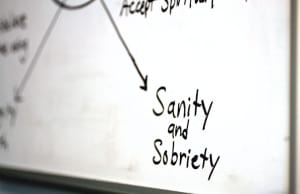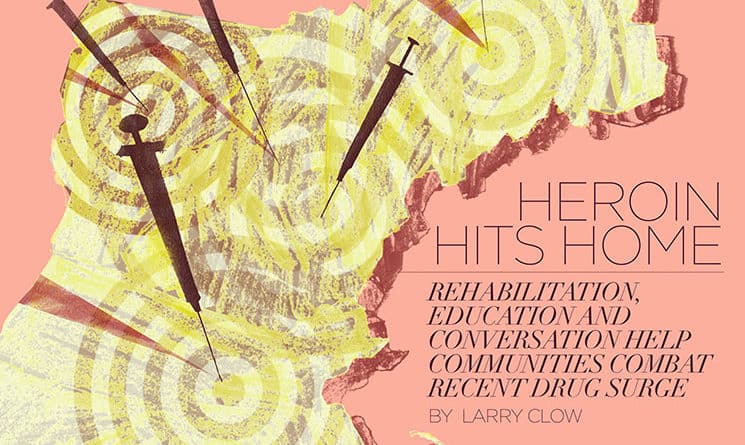Steve MacKenzie is the kind of teacher who stays in touch with his former students. Walk with him through the halls of Somersworth High School and it’s easy to see why — current students in the hallways will come up and give him a hug or tell him about the latest book they’re reading.
And that’s how MacKenzie realized earlier this year that there is a heroin problem in Somersworth.
“I was running into kids and reading about kids who I was extremely close with when they were in high school, and all of a sudden, I’m finding out they’re heroin addicts,” he says. “I got one or two of them to admit to me what was going on, and it just seemed that every day, I was finding somebody else who was an addict. These were kids who I loved dearly, kids who I knew well.”
MacKenzie, an English teacher, writes a regular column for Foster’s Daily Democrat about life in the classroom. In September, he wrote about three former students struggling with heroin addiction. The column shattered a heavy silence in the community. He received close to 50 emails from city residents. Other former students wrote to him about their addictions; mothers wrote about the toll addiction had taken on their children. One man wrote MacKenzie and said that, after three years of heroin use, he’d just celebrated his 13th day of sobriety. Three weeks later, MacKenzie found out the man had died.
“I just sat there and cried,” he says.
MacKenzie says he’s now aware of close to 40 former students who are addicted to heroin. They aren’t anomalies, and the problem isn’t only in Somersworth. The Seacoast, and New Hampshire as a whole, has seen a surge in heroin addiction and, with it, an increase in overdoses and crime related to the drug. It’s a complex problem that extends across New England and the nation.
There is no single solution when it comes to breaking heroin’s hold on the Seacoast. According to those affected by the drug, what the region needs is more recovery options, more education, and, most of all, more dialogue within communities.
A growing problem
“Almost everything we go to, as far as thefts and burglaries, seems to be tied to heroin.”
Capt. David Kretschmar, investigation division commander for the Somersworth Police Department, says the department has made 23 heroin-related arrests this year. “Almost everything we go to, as far as thefts and burglaries, seems to be tied to heroin,” he says.
The department’s internal reporting system only recently began tracking the number of overdose calls police receive. But anecdotally, Kretschmar says, officers have responded to between two and four overdose calls each week since May.
“Up until the last couple of years, we really didn’t see that much heroin around here,” he says. “It started to make inroads … 10 or 15 years ago, but even that was … a smaller circle of people we saw. Now it’s just exploded to the point where it’s the drug we expect to see when we go on a call.”
In Portsmouth, Deputy Police Chief Corey MacDonald says the number of heroin overdoses has “increased rapidly.” In the last six weeks, five people in Portsmouth have died from heroin overdoses. More than 45 times in the last year, MacDonald says, the city’s fire department has administered Narcan, a drug that reverses the effects of an opiate overdose. So far this year, the department has made 106 drug-related arrests, though that number includes other drugs, as well as heroin.
“We’re really seeing (heroin) drive crime, from big crimes like bank robberies to small crimes like people checking door handles” and breaking into cars, MacDonald says.
An October report by the Center for Disease Control and Prevention showed that New Hampshire and Massachusetts were two of 28 states with a “significant increase” in heroin-related deaths between 2010 and 2012. According to the New Hampshire Department of Health and Human Services, between 2010 and 2013, the number of heroin-related deaths increased from 13 to 70. Meanwhile, emergency-room visits related to heroin use jumped from 106 in 2012 to 224 in 2013.
In June, New England governors, including Maggie Hassan of New Hampshire and Deval Patrick of Massachusetts, met at Brandeis University to discuss regional strategies for combating heroin. In Somersworth, mayor Dana Hilliard established a commission to address the city’s heroin problem. The commission met for the first time earlier this month; it’s next meeting is scheduled for Jan. 6.
“One of the biggest challenges is getting people to understand that it’s not the same drug most of us grew up thinking about,” MacDonald says. “It’s not the dirty drug in the back alley. … It’s crossing all these socio-economic boundaries. Young adults from all over the place are getting started on pills and transitioning to heroin.”
Lost time

Greg Smith at Bonfire Recovery in Dover
Greg Smith is a recovering heroin addict. He’s been clean for about two months now and is living at Bonfire, a newly opened men’s sober home in Dover. It’s the seventh sober home he’s been in this year.
“Hopefully, it’s different this time,” he says. “It’s the hardest thing I’ve ever done.”
Smith is 24. Originally from Methuen, Mass., he describes himself as an “ex-IV heroin user.” His most recent run with heroin ended in Boston. He was out of money, “spiritually just broken down.” He woke up one morning, sick from withdrawal, and knew he had to call someone.
“It was either continue living like this and die, or choose life again,” he says. “I called my sister … and (my family) told me, this is it. We can’t keep saving you.”
Smith eventually wound up at Phoenix House, a drug treatment facility in Keene, and from there came to Bonfire.
His family, he says, is his number-one reason for committing to recovery. “I want them back in my life,” he says. “It’s everything I’ve lost. Not just materials, but time.”
Heroin isn’t a problem in certain states or regions. It’s everywhere, Smith says. “It’s taken the nation. Heroin’s made its major comeback in the last year or two, and it’s relentless,” he says. “It’s not getting any better; it’s getting worse.”
The root of the problem, he says, is opioid painkillers like oxycodone. People get hooked, either from taking the drugs for a prescription or trying them out recreationally. And, when that supply runs out, they turn to heroin. “It’s so accessible. It’s cheaper, and it’s just everywhere,” he says.
When addicts do have a moment of clarity and want to get clean, it’s hard to get help. “You make the phone calls, you call detox (centers), you go to the hospital,” he says. “But it takes time. You’ll get put on a waiting list. And even if you get into a place, you have to wait a week. … In my experience up here, it’s been so difficult to get into rehab treatment programs and sober homes. It just takes so much time.”
Recovery and education

A motivational message at bonfire
Recovery is a “challenging system to navigate,” says Sandi Coyle, a regional coordinator for the Seacoast Public Health Network. For people with substance abuse disorders, the lack of a centralized recovery service means a lot of waiting. That means their addiction has more time to reassert its hold, to wipe out that moment of clarity and knock them off the path to recovery.
Coyle is part of a coalition of local recovery

